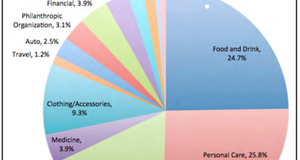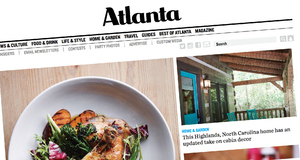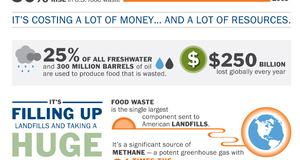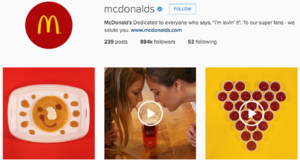From Elon Journal of Undergraduate Research in Communications VOL. 5 NO. 2Representations of American Culture in Food Advertisements in Mainstream, Latina, and African-American Magazines
IN THIS ARTICLE
KEYWORDS
AbstractThis study analyzed 54 advertisements for food products, grocery stores and restaurants in nine major women’s magazines in order to gain understanding of the values of American ethnic groups. The author divided the magazines by audience (mainstream, African-American, and Latina), and then coded the advertisements for themes like family, community, and nutrition. Food advertisements in mainstream magazines frequently emphasized that nutritious, delicious food could be part of a busy lifestyle, whereas ads in Latina magazines associated food with family, and advertisements in African-American magazines contained mostly taste-related claims. As America’s ethnic population continues to grow, it becomes increasingly important for advertisers to understand which messages will resonate with different racial and ethnic groups. IntroductionThe relationship between media and society is cyclical – media seek to understand and reflect society, but societal trends are also influenced by the media. Since effective media represent and contribute to society, the development of an advertising or public relations campaign always begins with research, and the insights gathered from this research are used to shape the campaign’s messaging. Advertisers can also target their audience with the demographic and psychographic information of a magazine’s readership, which is available in the magazine’s media kit. So the messages in an advertisement are not just creative musings from a copywriter at an ad agency – they are highly strategic and carefully crafted to resonate with the target audience. Because of all of the research that goes into advertisements, ads themselves contain deep insights into the mindset of the target audience. This research seeks to understand different American subcultures’ attitudes about food and wellness, using print advertisements as a lens. Understanding these attitudes may shed light on other broader values and beliefs of these subcultures. As America’s population becomes increasingly diverse, it is important to understand that not all Americans will respond to the same advertising messages, and advertisers must stay aware of cultural differences in their audiences. Because of the role food often plays in traditions, societies, and cultures, food advertisements can be especially telling about a culture’s values. This research seeks to understand the cultural values apparent in food advertisements aimed at various ethnicities. Literature ReviewFor American women, popular magazines are an important source of health information (Hoffman- Goetz et al. 262). Alongside editorial content in these magazines are ads, many of which also have strong messages about food and health. Previous literature found that advertisements are most effective when the reader can identify with the race or ethnicity of the models. Food is also “strongly connected to psychological, cultural, and socioeconomic factors, and thus with race and ethnicity” (Tashiro 161). Though previous studies have not focused particularly on food and health advertisements for different minority groups, many studies have been done on multicultural and ethnic advertising, food advertising, and cultural values surrounding food. Multicultural/Ethnic AdvertisingLooking at advertising through a multicultural lens is important for several reasons. Knobloch-Westerwick and Coates (2006) assumed that ads in media popular with minorities conveyed a different message than ads in mainstream media (569). Members of ethnic minorities are “likely to select media outlets and messages that relate to their ethnicity, whereas members of the white mainstream are unlikely to take that aspect into consideration” (597). Advertising in these outlets is also more effective when models represented have an ethnic background similar to that of the reader (605). So, onlookers are more likely to adopt behaviors, like using certain products, if they’re of the same race as the model represented in the advertisement (607). A study by Ahmad (2003) found that ethnicity might be more complicated that Knoblock-Westerwick and Coates suggested. Ahmad found that ethnicity is “not just who one is, but also how one feels in and about a particular situation” (1603). Minorities may be “expected to have multiple selves whereby they act differently in different situations and with different individuals” (1603). This suggests that a member of a minority group may have a different response to an advertisement depending on the product or service being advertised, the type of media outlet it is in, and a variety of other factors. Much previous research on multicultural health advertising has focused on cigarette and tobacco advertising. Fernandez et al. (2005) conducted a content analysis of magazines for Latinas, white women, and men. They looked at issues of Cosmopolitan, Glamour, Playboy, Cosmopolitan en Español and Glamour en Español published between January 1998 and August 2002 (144). They found that there were more cigarette ads per issue in magazines for white women (an average of 2.96) than in magazines for Latina women (an average of 1.0), suggesting a greater targeting of white women than Latina women by the tobacco industry (148-9). Over the years, the ads in white women’s magazines decreased, but they remained stable for Latina women (150). They also found that the cigarette brands most frequently advertised to white women were not “women’s brands” but instead were “white brands” like Marlboro, but Latinas were usually advertised “women’s brands.” This suggests that “the industry may view white women as less traditional in gender roles than Latinas” (150). This also may suggest that white women are perceived as more health-conscious than Latina women, since the cigarette advertisements decreased over time for white women but stayed steady for Latinas. Cigarette advertising for African-American women also decreased over time. Hoffman-Goetz et al. (1997) did further research on cigarette advertising when they looked at the correlation between cancer articles and tobacco advertisements in African-American magazines Jet, Ebony, and Essence published between January 1987 and December 1994. Though they found magazines to be an important source of health information for American women, they also found that “health messages and models in ‘traditional’ women’s magazines may have limited impact for African-American women” (262) and therefore these women may need to turn to magazines more targeted towards their race. The authors found a decrease in density of tobacco advertising in these African-American magazines throughout the years, but this was not accompanied by an increase in editorial coverage of cancers. This shows that the decrease in cigarette advertising may not have been related to an increase in health-consciousness among African-Americans. Food Advertisements in Mainstream Women’s MagazinesStudies examining nutritional claims in food advertising have found that food low in nutritional value tends to be the most heavily advertised. Lohmann and Kant (2000) studied the advertising frequency of different food groups in women’s magazines published in 1997. The researchers looked at two health-oriented food magazines (Cooking Light and Eating Well), two general women’s magazines (Ladies Home Journal and Good Housekeeping), and two health and wellness magazines (Prevention and Health). They found that foods with little nutritional content were most likely to be advertised – fats, oils, sweets, and beverages were advertised the most, but fruits and vegetables accounted for only about 5% of food advertisements in the magazines (1397). The most common claim made in the advertisements was good taste, which was present in 39 percent of all advertisements. The second most common claim was about modifications in fat, energy, sodium, or sugar, which accounted for nearly a third of all the ads. The number of claims actually dealing with health or nutrition was very low (1398). Parker’s 2003 study on food and health advertising noted that “the marketing of food continues to evolve from its promotion as a tasty necessity for life to a potentially health-enhancing experience.” The study cited a 2000 survey that found that 50 percent of respondents felt they were more likely to eat foods that reported to reduce the risk of heart disease and cancer (47). Parker looked at HNR (human nutrition research) claims in food advertisements based on recent FDA guidelines, the incidence and types of HNR claims, and the incorporation of regulation guidelines into the advertising of food products (48). Food ads from 108 issues of three popular consumer magazines between 1998 and 2000 were collected and analyzed to draw conclusions about advertising content and industry practices. Since the majority of women, ages 25 to 64, are primary food shoppers, the author looked at magazines with a high circulation and majority female readership, including American Health, Better Homes and Gardens, Cosmopolitan, Good Housekeeping, Modern Maturity, and Prevention. The ads were sorted systematically by publication, date, food group, food type, brand, and claim. The author provided HNR training to three content judges, two undergraduate students and one graduate student. The judges then worked independently to analyze all ads (50). Parker found that 41% of all ads contained at least one type of HNR claim, most commonly being a nutrient content claim. She also found that specific nutrient content claims, like information about calories or fat, were used more frequently than nutrition claims like “wholesome,” “nutritious,” or “healthy” (51). Like Lohmann and Kant, Parker found that the highest number of ads in the magazines was for the fats and sweets food group, which accounted for 22.7 percent of all ads. Fruits accounted for 5.9 percent of ads, and vegetables, 4 percent. The health claims were most often made in ads for breads/cereals, fruit juice, combination foods, and dairy. Parker’s study “reveals that food marketers continue to take a cautious approach with regard to the use of health claims in print advertisements and that they prefer to use nutrient content or structure/ function claims” (52). Overall, the study found that health claims are found infrequently in print advertising. American Cultural Values and Food ValuesAdvertisements are laden with cultural values. To better understand how and why food advertising differs across ethnic groups, one must first understand what each ethnicity and subculture values. Since magazines’ media kits provide easily accessible information about the readership’s household income, education level, age, and other demographic information, advertisers can use this knowledge to create advertisements that will appeal to the values of a magazine’s audience. Doran and Littrell (2013) aimed to measure mainstream American cultural values using the Schwartz Values Survey. They conducted a web-based survey and collected responses from a pool of potential subjects provided by four online retailers who sell teas, coffee beans, crafts, toys, scarves, purses, and jewelry. The retailers sent email invitations to potential subjects and asked them to participate. Internet users tend to be younger, more highly educated, white, and wealthier than non-users, and this group, according to the authors, is made up of “the makers and carriers of mainstream American culture” (268). The sample collected was nearly 80% white and 12.85% African-American (269) and the median age in the sample was 36.9 years. Though there were slight differences between states, genders, and urban/rural living settings, the authors found universalism, benevolence and self-direction to be strong motivating values for Americans. Power was the least motivating value (273). The authors also found that age has a significant positive correlation with conformity, tradition, and security, and a significant negative correlation with stimulation and hedonism. Education has a significant positive correlation with universalism and a significant negative correlation with conformity, tradition, hedonism, and security. Income has a significant positive correlation with power and achievement and a significant negative correlation with universalism and self-direction (272). Food and health may be associated with tradition, since so many events revolve around mealtimes and food. American culture also glorifies certain body types, which could create an association between power and a certain body type. Further research would be needed to understand how these values are portrayed in food advertisements. While Doran and Littrell focused on “mainstream” American cultural values, Gomel and Zamora (2007) sought to understand food and health values among a smaller subculture: Latina mothers. They conducted a series of eight focus groups among English-speaking and Spanish-speaking low-income Latina mothers of preschoolers to understand how they feel food is related to their children’s health and their roles as mothers. They took a convenience sample of participants from community resource centers and churches in Latino communities in Southern California (360). They asked participants questions like “How do you think food is related to a person’s health?” and “How important are mealtimes, like dinner, for your family?” (361). Both Spanish- and English-speaking mothers had similar beliefs about which foods are healthy and which are unhealthy, but only Spanish-speaking mothers felt that beans were a healthy diet staple. English-speaking mothers were also more likely to talk about eating in moderation than Spanish-speaking mothers were. Both groups also commented on the link between food and weight, cognition, and general wellness (362). Main differences in attitudes and beliefs involved wellness and weight. Three Spanish-speaking groups, but only one English-speaking group of mothers, felt that eating unhealthy foods over time was linked to issues such as diabetes, high cholesterol, and heart problems. Interestingly, only English-speaking mothers expressed concern or worry about their children being overweight (364). This suggests that food advertisements in American magazines written in Spanish may focus more on health and less on weight than advertisements in magazines written in English. A 2009 study also found differences in food preparation by race and ethnicity. The study was conducted under belief that food selection is determined by taste, nutrition, health, cost, and convenience, and is also strongly tied to psychological, cultural, and socioeconomic factors, and therefore race and ethnicity (Tashiro 161). The study uses data from the American Time Use Survey (ATUS) for the year 2005. The data contains 13,038 respondents, including household members aged 15 and older. Among them, 8,616 respondents were white; 1,235, African-American; 313, Asian; and 1,365, Hispanic. Tashiro found that whites and Hispanics reduce time spent on food preparation as their education increases, but highly educated Hispanics are more likely to spend time preparing food at home, “indicating that education increases health awareness and encourages healthier food consumption” (178). Whites, Hispanics, and particularly African-Americans increase time spent on food preparation when they devote more time to family care (178). Whites and Hispanics spend more time purchasing prepared food when their leisure time increases, but African-Americans increase time spent purchasing prepared-food when their working hours increase. This may cause a difference in the way convenience food is advertised to whites and Hispanics versus African-Americans. Overall, whites and Hispanics were more likely than African-Americans and Asians to spend time purchasing prepared-food. Previous research on multicultural advertising, food and health advertising, and cultural values all provides framework for understanding how food ads target different ethnic groups. This research aims to understand how food and health advertisements embody and appeal to values, attitudes, and beliefs of different cultural groups. This research can help advertisers effectively target and resonate with Americans from ethnic backgrounds that may differ from the “mainstream.”Continued on Next Page » Suggested Reading from Inquiries Journal
Inquiries Journal provides undergraduate and graduate students around the world a platform for the wide dissemination of academic work over a range of core disciplines. Representing the work of students from hundreds of institutions around the globe, Inquiries Journal's large database of academic articles is completely free. Learn more | Blog | Submit Latest in Business & Communications |



















